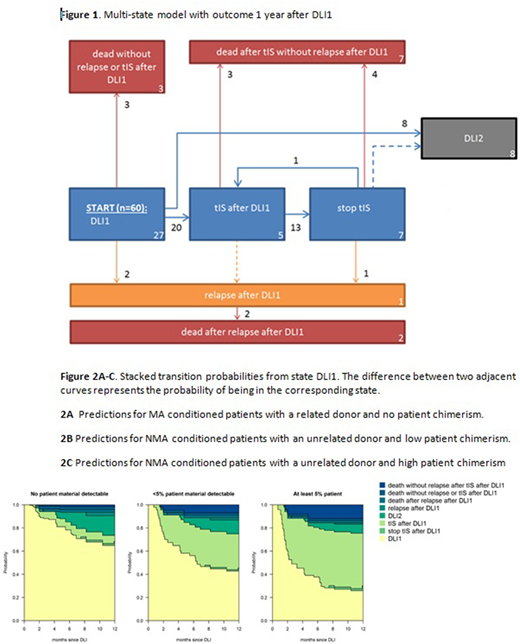Abstract
After allogeneic stem cell transplantation (alloSCT), donor T cells targeting patient derived hematopoietic cells can induce a Graft versus Leukemia (GvL) effect preventing relapse. However, targeting of healthy patient tissues can cause Graft versus Host Disease (GvHD). The inflammatory environment induced by pre transplantation conditioning, the number of donor T cells in the graft, genetic disparity between patient and donor and the presentation of allo-antigens by activated patient derived antigen-presenting cells (APC) to donor T cells play a role in the development of GvL and/or GvHD. Donor T cell depletion (TCD) reduces GvHD and GvL. After TCD alloSCT, postponed prophylactic donor lymphocyte infusions (pDLI) are often needed to induce a GvL effect. When using 10/10 matched donors, our first dose of pDLI at six months after TCD alloSCT contained 3.0x10^6 T cells/kg (related donor, RD) or 1.5x10^6 T cells/kg (unrelated donor, UD). We evaluated whether the risk of developing GvHD after DLI is influenced by the donor type, intensity of the conditioning and/or patient bone marrow (BM) chimerism at time of DLI
Sixty patients with acute leukemia (52 AML, 8 ALL; median age 57; 27 RD, 33 UD) received pDLI at a median of 6.4 months after TCD alloSCT in the absence of GVHD or relapse. Twenty-four patients received myeloablative (MA) conditioning consisting of cyclophosphamide and TBI. 36 patients received non-myeloablative (NMA) conditioning based on fludarabin and busulphan. TCD was performed by adding 20mg alemtuzumab to the graft. Only MA conditioned patients with an UD (n=12) received post transplantation ciclosporin as GvHD prophylaxis, which was tapered from 1 month after alloSCT. Clinically significant GvHD was defined as need of therapeutic systemic immunosuppression (tIS) for GvHD for at least 2 weeks or until death. Bone Marrow (BM) chimerism was measured prior to DLI. Three categories of patient chimerism levels were defined: no patient derived cells (absent), patient derived cells present, but < 5% (low), or ≥ 5% (high). In case of persisting or increasing patient chimerim after pDLI, a second DLI was given at 3-6 months after the first. A multi-state model was designed (Figure 1) with the first DLI (DLI1) as starting state and time. Patients starting tIS after DLI1 transit to the state tIS. Patients who need a second DLI, develop a relapse or die, transit to these respective states. Patients who stay in the state of DLI1 are considered to have a positive outcome. All patients had a follow-up of at least one year after DLI. Numbers in the boxes in Figure 1 represent the number of patients in that state at 1 year after DLI1 and numbers next to the arrows indicate the numbers of patients who made the transition between the two states. Donor type (unrelated versus related), conditioning (NMA versus MA) and patient BM chimerism at time of DLI were included in a Cox model for the transition hazards to investigate their association with the development of GvHD after DLI.
For the total group, the cumulative incidence of tIS at 1 year after pDLI was 33% (95% CI 21-45%). Patients with an UD had a hazard ratio (HR) of 1.1 (95% CI 0.4-3.3) of needing tIS after DLI1 compared to patients with a RD. Compared to MA conditioning, NMA conditioned patients had a hazard ratio of 2.1 (95% CI 0.5-8.9) of needing tIS after DLI. They had a HR of 0.2 (95% CI 0.04-0.95) of stopping tIS compared to MA conditioned patients, indicating that DLI after NMA conditioning is associated with more severe GVHD. We hypothesized that this was due to the persistence of patient derived APC. BM chimerism at time of DLI was measured in 47 patients. After NMA and MA conditioning, BM patient chimerism was absent in 14% and 56%, low in 41% and 39%, and high in 45% and 6%, respectively (Fisher's exact test p=0.002 for difference between type of conditioning). Compared to the group without patient chimerism, the low and high patient chimerism group had a HR of 1.9 (95% CI 0.9-4.2) and 3.6 (95% CI 1.7-8.0) of needing tIS after DLI, respectively (Figure 2), demonstrating that the level of patient chimerism is a strong predictor for development of GvHD after DLI, even when taking into account the type of conditioning regimen.
Patient BM chimerism at time of pDLI is a strong and independent predictor for the risk of developing GvHD. Dose reduction in case of an UD equalized the GvHD risk compared to a RD. When choosing a T cell dose for pDLI, patient chimerism should be considered a relevant parameter.
No relevant conflicts of interest to declare.
Author notes
Asterisk with author names denotes non-ASH members.


This feature is available to Subscribers Only
Sign In or Create an Account Close Modal